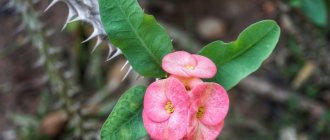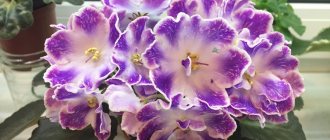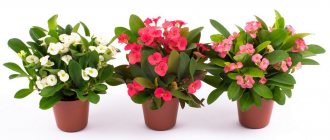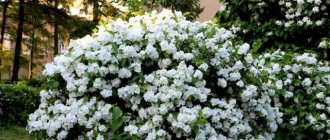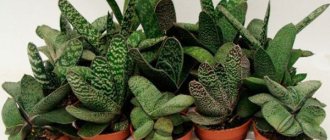Plants » Flowers
0
641
Article rating
Kira Stoletova
Euphorbia obesa is an original Euphorbia species native to South Africa. It grows in the Kendreu area on rocky shale soils. It has a decorative appearance, resembling a slightly ribbed ball. Its other names are “plump” or “fat,” but the Americans nicknamed the succulent “baseball plant.”
Decorative spurge
Description
Garden spurge belongs to a large genus, which includes about two thousand plant species, which, in turn, belong to the Euphorbiaceae family.
The huge species diversity includes both annual and biennial plants, as well as perennial plants. Among the many euphorbias there are highly ornamental and weedy species that gardeners have great difficulty removing from their plots.
For the most part, representatives of the genus are found in African territories, but about 20 species are perfectly adapted to the harsh realities of the Russian climate.
Unfortunately, precisely because of the species diversity, it will not be possible to give a general description of milkweeds , since the plants have strong differences in stem height, leaf shape and bush structure.
But all milkweeds have one thing in common: milky sap.
For people who are allergic to latex, contact with the milky juice is strictly prohibited. The fact is that the juice contains rubber - a natural raw material for the production of latex.
You need to be very careful when working with milkweed: a couple of drops of juice on the skin can cause itching, redness and even ulcers.
If it gets into the eyes, it leads to partial loss of vision and severe burns to the cornea. The juice that reaches the stomach causes severe vomiting , diarrhea, and increased body temperature.
When they bloom, milkweeds produce attractive, brightly colored petals that are mistaken for flowers. But these are not petals, but leaf plates that are designed to attract insects to pollinate the flower itself, which is rather inconspicuous.
Beneficial features
This plant has healing properties - its benefits are expressed in the ability to cure fungal skin diseases, eczema, warts, and lichen.
The roots are used in the treatment of diseases of the gastrointestinal tract. An alcoholic tincture of milkweed helps get rid of cystitis and headaches.
The flower can also cause serious harm - the milky sap is dangerous and has a toxic effect on the body. Causes severe burns to the skin and mucous membranes. Therefore, care must be taken to ensure that a child or pet does not accidentally eat the leaves or stems.
Garden spurge: types, photos and names
From almost 2000 varieties, every gardener will be able to choose a plant to their liking. Among the most popular ones used for garden decoration are the following.
Multiflora or polyflorum (Euphorbia epithymoides)
The natural habitat of this species is the mountainous regions of Europe. The perennial plant in the process of development forms a beautiful rounded crown of the correct shape, which, with a bush height of 0.5 to 0.7 m, creates an attractive picture.
The basal leaves are scaly, they form a rosette; the same ones that are located on the stem, round in shape. The leaf-spreads are painted in a light yellow tone, which acquires a beautiful orange color at the time of flowering. The flowering period takes a little more than a month, occurring in May – June.
Almond (Euphorbia amygdaloides)
A fairly large perennial, whose height can reach 0.7 m. Moreover, the underground part, represented by a horizontal woody root, often coincides in size with the above-ground part.
In the first year of life, the bush produces vertically oriented shoots, which become woody over time. They are densely covered with petiolate dark green leaf plates of an elongated elliptical shape.
The apical rosette of leaves overwinters on the bush, and the next year small shoots appear from it, covered with sessile greenish-yellow leaves framing the peduncles.
Flowering occurs in April - May.
Cypress (Euphorbia cyparissias)
A low (up to 0.4 meters) variety of milkweed with erect shoots, densely covered with needle-like leaves. As it grows, it forms dense clumps.
A notable feature of the plant is its ability to re-bloom : the first wave occurs in May, the second at the beginning of autumn. When flowering it spreads a pleasant aroma.
The petals-spreads of some varieties may have a delicate pink color, but in most plants they have a purple or burgundy tint.
Marginata (Euphorbia marginata)
Grown as an annual, it is distinguished by well-branched, vertically oriented shoots, whose height can reach 0.8 m.
The shoots are densely covered with light green, fairly large (up to 4 cm in length) oval-shaped leaf plates. The arrangement of leaves can be alternate or whorled.
The bush is characterized by long flowering , which lasts from July to mid-September. At this time, the apical leaf plates of garden milkweed receive a bright white border, and the bedspreads surrounding the inflorescence turn completely white.
Myrtle leaf (Euphorbia myrsynites)
This plant is simply irreplaceable when decorating rocky areas or alpine hills. The fleshy creeping stems are not too tall, their length is only about 0.2 m. The shoots form rosettes.
On the stems there are a large number of medium-sized leaf blades of an obovate shape with a remarkable greenish-blue color.
At the top of each shoot, capitate inflorescences are formed . The leaves that form the blanket are tightly curled around the flower and vaguely resemble a rose with greenish-yellow petals.
The flowering period takes all of May and most of June, but in warm springs flowering can begin in April. The plant reproduces well by self-seeding; this must be kept in mind when planting.
Capitulata (Euphorbia capitulata)
An interesting compact variety. Prefers rocky, well-lit areas. The height of the shoots is about 0.1 m. The flowering period occurs at the end of spring, and at this time capitate spurge becomes an expressive decoration of the site.
Stone-loving (Euphorbia petrophila)
A herbaceous perennial plant whose shoots at the base become woody over time. The color of the stems has a reddish or brownish tone. The height of the shoots does not exceed 0.2 m.
Foliage from previous years leaves scar marks on the stems, which can be used to approximately determine the age of the plant.
The leaf blades have an elongated elliptical shape, about 2 cm in length, and are distinguished by the presence of a serrated edge. The color of the foliage is greenish-gray, the integument is leathery, and the leaves themselves are quite dense.
Flowering occurs at the end of May and lasts until the beginning of July. The inflorescences are wrapped in burgundy egg-shaped blankets ; they are formed by 3–5 flowers.
Swamp (Euphorbia palustris)
The color of the erect long shoots, reaching a meter in length, is noteworthy - it is burgundy.
There is a lot of foliage on the shoots; it is rich green with a noticeable light cream longitudinal vein. The flowering period occurs at the end of May, at which time the plant forms fiery yellow inflorescences.
Chin or caper (Euphorbia lathyris)
This variety has a two-year life cycle and quite impressive growth (up to 1.5 m). The plant is suitable for areas located in light shade.
In the first year of life, milkweed produces an erect shoot, distinguished by a reddish color. In the second year it forms flowers and dies after flowering. The variety reproduces well by self-sowing.
Vegetable garden (Euphorbia peplus)
Since this variety is completely undemanding to soil quality and instantly reproduces by self-sowing, it is often pulled out as a weed.
But a certain decorative quality is still inherent in the low bush. And if you monitor the growing season of the plant, and immediately remove the corollas after flowering, then garden spurge may well be present on the site.
Griffith or fire (Euphorbia griffithii)
This large (up to 0.8 m in height) plant is a striking example of highly decorative milkweed. Its vertical shoots form a rounded bush and are densely covered with elongated leaf blades with a bright longitudinal stripe on each.
During the flowering period, inflorescences with red, orange or yellow petals appear on the shoots.
Cornigera (Euphorbia cornigera)
Not too bright, but an atmospheric plant, whose bush is formed by erect shoots up to 0.8 m long. The flowering period occurs in the second half of summer.
The plant forms inflorescences of horny greenish-yellow flowers. The leaves are elongated-lanceolate, dark green, with a noticeable light stripe in the center.
Schilling's (Euphorbia schillingii)
A tall bush can reach 1 m in height and serves as an excellent background for flowering perennials without overwhelming them with its blooms.
The color of the petals is yellowish-green, but not too bright. The leaf blades are elliptical in shape, rich green in color, and are distinguished by a noticeable longitudinal stripe.
Mediterranean or sculptured (Euphorbia characias)
It is distinguished by its large bush size (up to 1.5 m), early and long flowering. During the flowering period, the bush is abundantly covered with inflorescences-tassels of light green color. The bluish-green leaves have a beautiful elongated shape.
Altai (Euphorbia altaica)
A herbaceous perennial whose height does not exceed 0.2 m. The shoots do not branch; they are divided into generative and vegetative.
The shape and size of the leaves vary: at the base of the shoot they are ovoid and medium-sized (about 3 mm), at the top of the shoot the length of the leaf can already reach 3 cm, and its shape takes on an elongated oval shape.
During the flowering period, yellow-green umbrella inflorescences with a wide bell-shaped leaf-spread appear on the tops of the shoots.
Rocky (Euphorbia rupestris)
A low bush, whose vertical shoots do not exceed a height of 0.2 m. There are few leaves on the shoots, thanks to which the openwork shape of the bush .
The leaf plates themselves are very beautiful; they constitute the main decorative value. The leaf length can reach 4 cm with a width of 1.5 cm; they are painted in a bluish tone, but have bright white veins.
Scaly (Euphorbia squamosa)
This spurge attracts attention with the correct spherical shape of the bush. The height of the plant reaches 0.4 m. Oval light green leaves and yellow inflorescences complete the picture.
How to care for a milkweed tree Mila
Like all other types of milkweed, Mili's milkweed is unpretentious and hardy. It can be recommended to inexperienced flower growers, as well as to those who do not have the opportunity to devote a lot of time to a green pet. Below is information on how to care for a houseplant, Euphorbia Mila, and tips on maintaining the succulent.
Lighting. The tree prefers to grow in plenty of sunlight, so south-facing windows are optimal for growing it.
In the summer, when the sun is most aggressive, you need to remove the flower to another place, preferably with diffused light, where direct rays will not fall on it. Otherwise, you will have to create shading so that the leaves do not get burned. In the autumn-winter period, additional lighting is used, which will help maintain the desired light regime.
In good light, the plant pleases with abundant, long-lasting flowering. With a lack of light, buds form less frequently, and the growth rate of the bush noticeably decreases.
Air temperature. The succulent is heat-loving by nature and does not like sudden temperature changes, as a result of which it stops developing. The optimal temperature range for its cultivation is 22 – 30 degrees. You cannot keep the plant near an open window where cold air enters and in a draft; this has a detrimental effect on its well-being.
Soil and pot. You can grow Euphorbia Mila in succulent soil. The plant will feel great in a substrate consisting of leaf humus, charcoal and coarse sand. The components are taken in equal volumes.
The root system of this crop is superficial and grows quickly; based on this, you need to select dishes for it. The pot should be medium in size, not too deep, but roomy. A wide container will not suit the plant
It is important that the pot has drainage holes to allow excess moisture to escape.
Fertilizer. Mineral fertilizers will help maintain the health and beautiful appearance of the plant. Fertilizing should be done 2 times a month from March to September. Milk bone meal has a good effect on your well-being.
Watering. Regular but moderate watering is necessary for the growth and flowering of this crop. You cannot over-moisten the soil, as this will damage the root system, which will inevitably lead to fungal diseases or death of the plant. Before the next watering, the top layer of the substrate must dry out. Normally, it is recommended to water in spring and autumn once every 10 days, in hot summers 1-2 times a week, in winter - once a month.
Air humidity. Air humidity does not matter for this plant. Periodically you need to wipe the leaves with a damp cloth. This work is carried out to remove dust accumulated on their surface. You cannot spray spurge, as the leaf blades can be damaged by moisture that gets on them.
Trimming. Milk's milkweed needs pruning to maintain a neat crown shape, as well as for its lushness. This procedure is best performed in spring and summer.
For pruning, use sharp, clean scissors and gloves. Before you start pruning Mil's milkweed, you should be well prepared and remember that it is dangerous to work without gloves, since the poisonous milky sap of the shoots can leave burns on the skin of your hands.
Growing plants from cuttings
Euphorbia is an unpretentious crop that is easy to care for and does not cause much trouble when growing.
Plants propagate well from root or stem cuttings.
To do this, the prepared material is placed in a peat substrate. The plantings are covered with film to create a greenhouse effect and regularly sprayed with a spray bottle.
For quick rooting, you need to maintain high air humidity and keep the substrate slightly moist all the time.
Due to high humidity, the greenhouse is opened daily for ventilation to prevent mold from growing.
A sign that the cuttings can be planted in individual pots and the shelter removed will be the appearance of new shoots.
The necessary conditions
Suitable location and soil requirements
The succulent needs constant diffused light, so the most suitable place for it is the southern or southeastern zone of the room.
For homemade milkweed, a ready-made substrate intended for succulents is suitable. Gardeners usually add baking powder to it in order to increase aeration - vermiculite, expanded clay. The soil mixture can be made from turf, peat, humus and coarse river sand, taken in equal proportions.
Temperature
Optimal temperatures:
- in summer, at the stage of active vegetation, 18°C-22°C;
- in winter, in the resting phase, not lower than 15°C.
In the summer season, removal to the open air with shading from direct sunlight is recommended.
It easily tolerates temperature changes, but is susceptible to drafts.
Humidity
Euphorbia does not need to be sprayed
The succulent copes well with being surrounded by dry air and does not need additional moisture. When spraying, water that gets on the foliage and stems provokes the development of putrefactive processes.
Optimal indicators are 30-50%.
When heating devices are actively used in winter, the humidity is increased by placing the pots in a tray filled with wet expanded clay.
Lighting
To maintain the decorativeness and brightness of the leaf mass, milkweed requires good lighting. The optimal length of daylight is 10 hours or more. In winter, the lack of sunlight is compensated for by supplementary lighting with artificial sources - fluorescent lamps.
Planting and care in open ground
Many types of milkweed are completely undemanding in terms of keeping conditions and reproduce well by self-sowing. But in order for the bush to actively develop and bloom luxuriantly, it will require a simple set of care measures.
Selecting a location
In most cases, preference should be given to open, well-lit areas with loose, permeable soil. But even on poor, acidified soils, spurge will not disappear, the flowering will simply be less spectacular.
Deadlines
The optimal time for planting seedlings or rooted cuttings will be mid-May - the time when the threat of return frosts has completely passed.
Outdoor sowing of seeds
The second half of May is also suitable for sowing seeds in the ground.
To improve the germination of seeds, it is recommended to stratify them (keep them in the refrigerator for two weeks), after pre-treating the surface with fine sandpaper.
Watering mode
Euphorbia is surprisingly unpretentious; it is recommended to water it only in hot weather .
However, you should not allow the soil to dry out after planting young plants - this threatens to reduce the growth rate of the plantings.
Reproduction: step-by-step instructions
Unlike most milkweeds, Euphorbia obesum reproduces exclusively by seeds. Other methods are unacceptable to him. To obtain seeds, two plants are needed - with female and male flowers.
- When the plants begin to bloom, pollen from the male flower is transferred to the female flower using a cotton swab or brush.
- After pollination, the female plant is covered with gauze or mesh to avoid seed loss.
- Full ripening of the seed material takes place in 10-12 days.
- After the seed pods have burst, the mesh is carefully removed and the seeds scattered in it are collected.
- For sowing, prepare a container with coarse, preferably river sand mixed with fine gravel.
- The seeds are laid out on the substrate, maintaining a distance of 5-7 cm between them, and lightly sprinkled on top.
- The soil is well moistened with a spray bottle and covered with glass or film. For better germination, it is better to place the greenhouse under a lamp or on a sunny window.
- The first shoots appear 15-20 days after sowing. When greenery appears, the greenhouse begins to gradually open, starting from 10-15 minutes and gradually increasing the opening time as the plants grow.
- After 3-4 weeks from the first shoots, young succulents are transplanted into separate containers.
Diseases and pests
The only disease that poses a threat to milkweed is a fungus, the development of which is provoked by high soil moisture. To prevent the development of the disease, it is enough to follow the watering regime.
Dangerous pests include mealybugs and spider mites. Insecticides will help reduce insect activity.
Lighting
The plant loves light very much, as befits succulents. Therefore, we put it where there is the most light: these are the southern, western and eastern windows. On the north side, euphorbia will stop growing and may even die. My milkweed grows on the south side and sometimes blooms.
There is only one problem that makes the appearance of the plant not entirely aesthetic. This is the bowing that occurs when a flower tries to turn its leaves towards the light source. To avoid this, I rotate the pot periodically.
